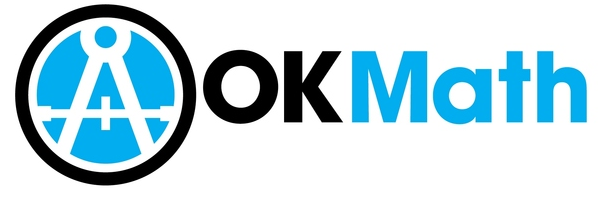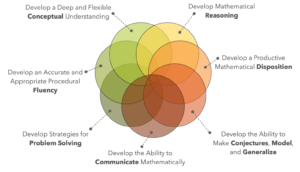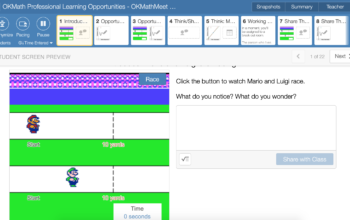At some level, principals have always been the instructional leader of their building. With new assessments and standards, never before has this role been more important. With the day to day paperwork mounting and parents or students always knocking at their door, when do principals have time to research and delve into curriculum and standards to bring their “A-game” each and every day? As a curriculum content specialist, I am called upon by principals to keep them in-the-know of what exactly the Oklahoma Academic Standards are asking and how best can their teachers present this knowledge to the students. When it comes to math, there are 5 simple ideas I can pass along to principals to help them best support math instruction in the classroom:
- Know the Oklahoma Academic Standards;
- Understand the standards for mathematical practice;
- Recognize Bloom’s questioning;
- Appreciate writing integration; and
- Support extension and application of concepts.
1. Know the Oklahoma Academic Standards
Beginning this year, schools have started implementing new Oklahoma Academic Standards in math. Specific topics have shifted to different grades levels, changed in depth of knowledge or been eliminated altogether. The new math standards also show a precise and logical progression through grades so teachers can clearly see how the standards they are teaching directly relate to standards in another grade. So, as the instructional leader of a school, it is imperative that principals have a grasp on these new standards to provide support through the TLE process.
Check out this resource:
- Download grade-level OAS-M standards - https://sde.ok.gov/sites/ok.gov.sde/files/OAS-Math-Final%20Version_3.pdf
2. Understand the Oklahoma Mathematical Actions and Processes
While the Oklahoma Academic Standards are grade and subject specific, the Oklahoma Mathematical Actions and Processes pertain to all grades kindergarten through 12th grade. The standards spell out quality teaching practices that teachers should be seeking to develop within their students to gain college and career readiness. Understanding these standards will allow principals to help teachers create classrooms full of students who reason, apply and truly understand mathematics.
Check out these resources:
- View the OKMath Frameworks to see the Mathematical Actions and Processes applied to the standards and objectives - http://okmathframework.pbworks.com
- Find other great videos of great math teaching at the Teaching Channel - https://www.teachingchannel.org/videos?page=1&categories=subjects_math,topics_common-core&load=1
3. Recognize Bloom’s questioning
Research has proven that by using Bloom’s higher levels — analyzing, evaluating, and creating — when questioning students, teacher can create better problem solvers in students. In the math classroom, Bloom’s questions should sound different because, when asked correctly, the answers given allow a teacher to delve into the minds of students to see how math is understood and applied to get an answer. No longer can math teachers be content with a given number or statement for an answer. The reasoning and synthesis needed to arrive at that particular answer is just as important. Principals should be expecting higher level questioning of students by their teachers and also students questioning each other. When walking through a classroom, ask students to analyze problems and use their knowledge of mathematics, assumptions and definitions to generate a certain type of conclusion or answer.
Check out this resource:
4. Appreciate writing integration
Teachers are incorporating writing in math class to help students reflect on their learning, deepen their understanding of important concepts by explaining and providing examples, and create important connections to real-world applications of the math they are learning. These writings can be used to assess student understanding of topics and identify a student’s attitude toward learning mathematics. Writing in mathematics looks very different from a language arts classroom because there are not defined rules and procedures. Writing about thinking is challenging but so beneficial for both teachers and students. Help teachers look for simple ways to incorporate short writings throughout daily lessons. Though it is challenging to begin this practice, it is well worth the effort.
Check out this resource:
- Writing in Math from MathWire.com - http://www.mathwire.com/writing/writing1.html
5. Support extension and application of concepts
Math teachers are faced with the daily challenge of making math come alive for their students and become a part of their everyday lives outside of the classroom. Whether they are shopping for the latest pair of kicks or planning to drive cross county for spring break, students are using math to get things done. Teachers are becoming very innovative in ways of incorporating real-world examples of mathematics into their teaching through guest speakers, field trips, webinars, and projects. Encourage these teachers to dream big and think outside of the box. Help them utilize every resource available within a school and a community, from businesses, sports teams, to post-secondary educational institutes.
Check out these resources:
- Elementary Project Based Learning Ideas - http://www.squidoo.com/math-project-ideas-examples
- Secondary Project Based Learning Ideas - http://emergentmath.com/my-problem-based-curriculum-maps





